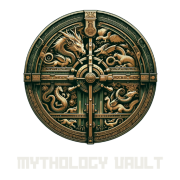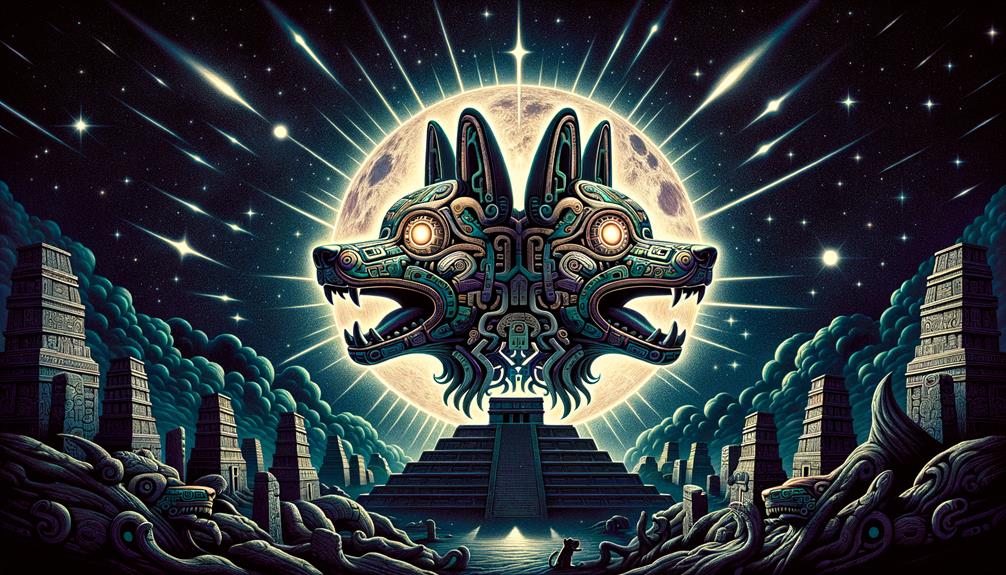Xolotl, the twin dog god, possesses a duality that encapsulates life's cycle within Aztec mythology. His skeletal form, with reversed feet, portrays his authority over the underworld and his role as a psychopomp – guiding souls through the perilous afterlife. As Quetzalcoatl's twin, Xolotl symbolizes the intricate balance between creation and destruction. This archetype's cultural significance and associated rituals shed light on deeper mythological interconnections.
Origins and Background
Mesoamerican myths paint Xolotl as Quetzalcoatl's twin, an intriguing figure representing existence's darker, mysterious side. Pre-Aztec traditions birthed Xolotl's narrative, a dog-headed deity tasked with guiding souls into the afterlife. Dogs were sacred, linked to the underworld – Xolotl's canine form highlighted his gatekeeper role between life and death.
Beyond ferrying souls, Xolotl shielded them from underworld perils, his protective nature reflecting duality's harmonious balance personified alongside Quetzalcoatl. The twins embodied contrasting yet interconnected energies mirrored throughout Aztec cosmology. Through Xolotl, practitioners grappled with archetypal themes like guardianship, unseen realms, and the interplay of opposing forces shaping the cosmos.
Role in Aztec Mythology
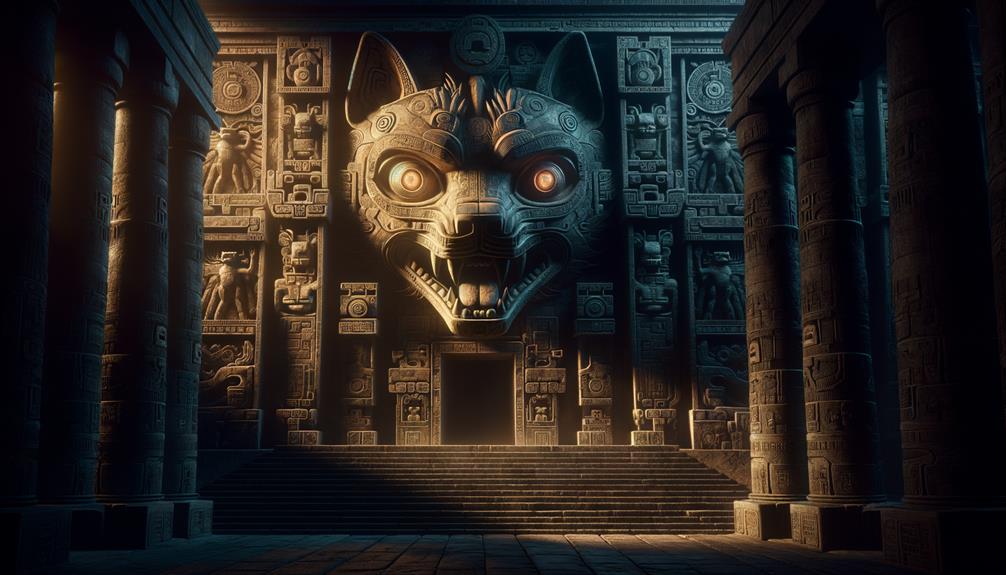
Xolotl's versatile role in Aztec mythology transcended his duties as Quetzalcoatl's twin, establishing him as the guide for the Sun's nightly journey through the underworld. This canine god, with his skeletal features and reversed feet, embodied themes of death and transformation central to Mesoamerican beliefs. As the evening star, Xolotl personified the intertwined nature of life and death.
One pivotal duty involved leading souls to the afterlife, a nod to the ancient human-canine bond. His connection to the Mesoamerican ballgame highlighted Aztec cultural values – the game symbolized the cosmic clash between life and death, order and chaos.
| Role | Symbolism | Cultural Significance |
|---|---|---|
| Quetzalcoatl's twin | Duality | Reflected mythology's interconnectedness |
| Underworld guide | Death and rebirth | Emphasized life's transitions |
| Evening star | Link between realms | Connected celestial and earthly domains |
| God of monsters | Protection | Relationship with the unknown |
| Ballgame patron | Cosmic struggle | Represented life-death cycles |
Through these archetypal themes, Xolotl's mythology role illuminated Mesoamerican cosmology's profound depths.
Xolotl and Quetzalcoatl
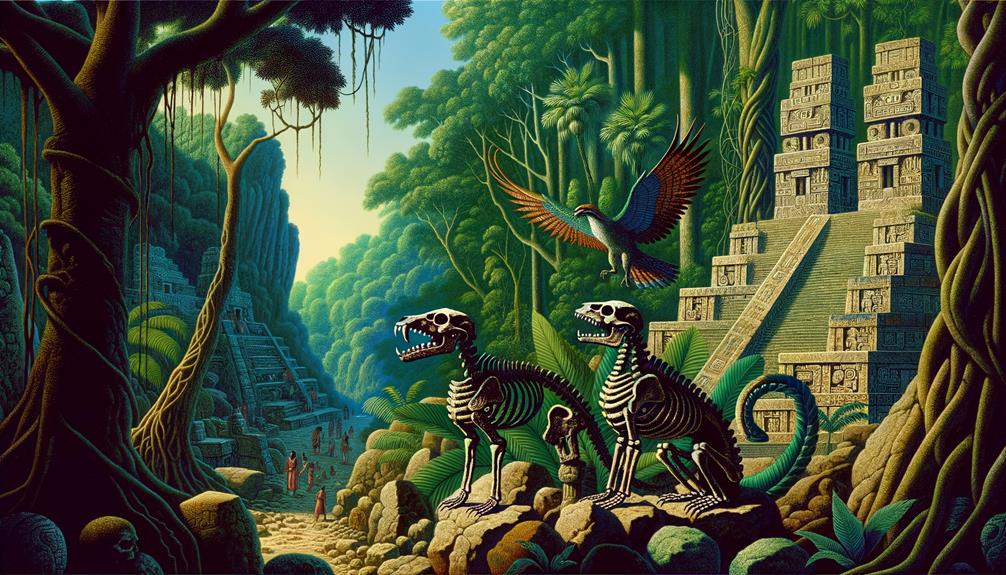
Xolotl and Quetzalcoatl, twin deities in Aztec mythology, embody the profound dualities of existence. Quetzalcoatl, the majestic feathered serpent, symbolizes enlightenment and vitality, while Xolotl, with distinctive canine features, represents death and transformation. Their contrasting natures illustrate the cyclical balance between life and demise – an integral tenet of Aztec beliefs.
Quetzalcoatl personifies wisdom and the animating forces of nature. His association with wind underscores the importance of spiritual growth. Conversely, Xolotl guides souls to the underworld, highlighting the inevitability of death for all beings. This interplay between the feathered serpent and dog-faced deity reflects the cosmic cycle: creation and destruction in perpetual motion.
The complementary roles of Xolotl and Quetzalcoatl reinforce the Aztec understanding of equilibrium. Life and death aren't opposing forces but two facets of the same cosmic dance. True harmony emerges not from denying either, but by embracing the totality of the human experience – a profound lesson embodied by these mythological twins.
Symbols and Depictions
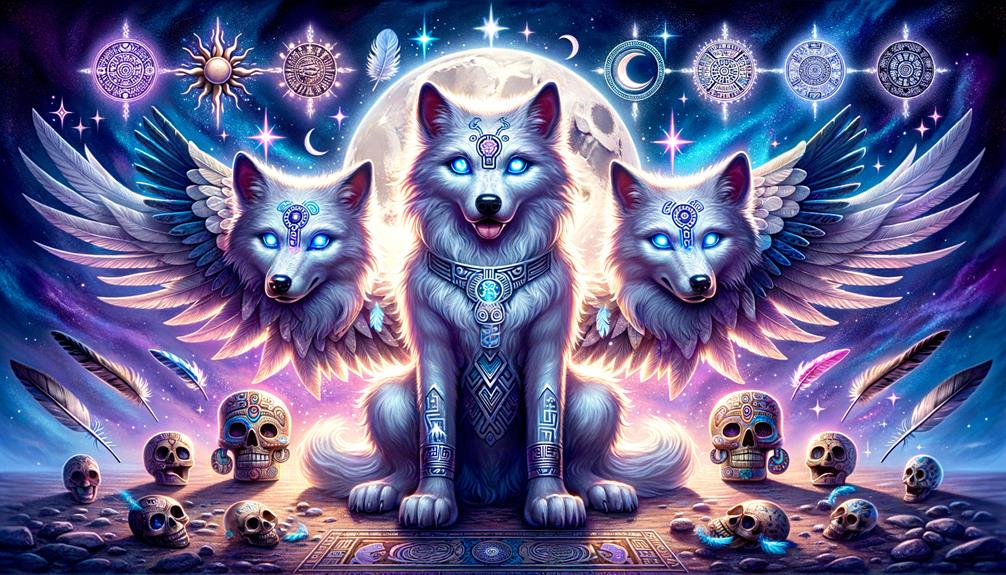
Xolotl, the enigmatic Aztec deity with a distinctive canine visage, unveils profound insights into the darker realms of the ancient cosmology. This deity's skeletal form and reversed feet symbolize his reign over death and transformation, guiding souls through the underworld. The Xoloitzcuintli breed, revered as sacred animals, reinforces Xolotl's profound connection to the canine world.
Portrayed as a deformed monster, Xolotl embodies the fears and mysteries that pervaded the Aztec psyche. His role as the god of monsters and deformities underscores this embodiment. Unlike his radiant twin Quetzalcoatl, Xolotl represents the balance of light and dark, life and death, within comparative mythology.
Symbols and depictions of Xolotl offer a captivating window into the complex interplay of reverence, fear, and transformation that defined Aztec belief systems. This enigmatic deity's imagery and representations illuminate a realm often overshadowed by his luminous counterpart, unveiling the profound depths of this ancient culture's relationship with the unknown.
Cultural Significance
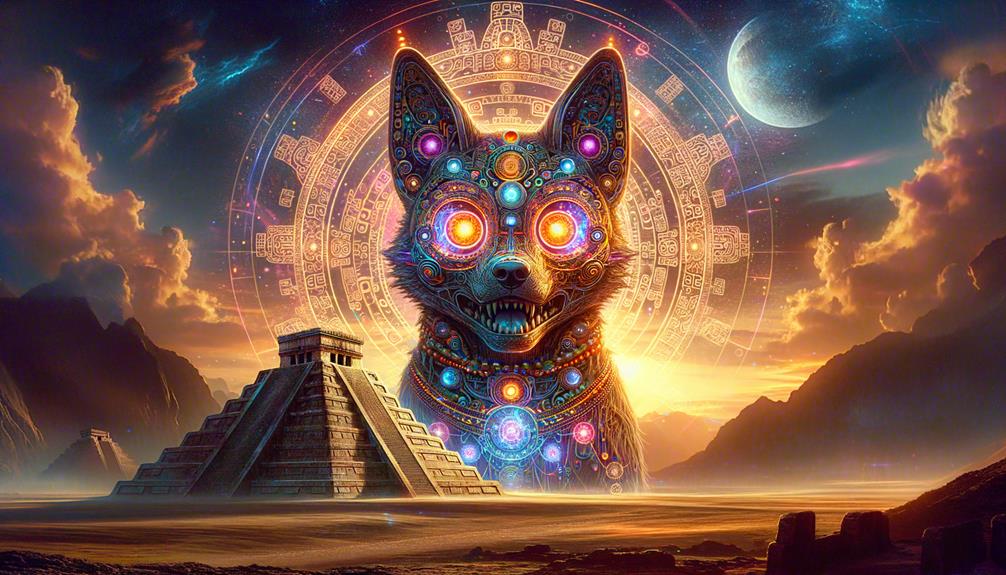
Exploring Xolotl's cultural relevance unveils how the twin dog deity personifies duality and cosmic equilibrium, pivotal themes in Aztec mythology. Xolotl's dynamic with his twin Quetzalcoatl symbolizes life and death, light and darkness, creation and destruction intertwined. This duality formed the bedrock of the Aztec worldview, where complementary forces shaped the cosmos.
The revered Xoloitzcuintli breed, closely tied to Xolotl, accentuated his role as a protective guide. These dogs were cherished not just as earthly companions but spiritual advocates in the afterlife. They guided souls through Mictlan's treacherous underworld, ensuring safe passage to eternal rest.
Xolotl's twin nature embodied the Aztec belief in harmonizing opposites. Feared yet revered, his ability to traverse realms highlighted existence's interconnectedness and opposing forces' essential harmony. As sacred companions, the Xoloitzcuintli breed mirrored this duality, symbolizing loyalty and guardianship in life and death alike. Through Xolotl, the Aztecs witnessed the eternal dance of complementary forces underpinning their spiritual and cultural ethos.
Frequently Asked Questions
Why Was Xolotl the God of Twins?
Xolotl was the Aztec twin god, tied to Quetzalcoatl through their yin-and-yang dynamic. Their bond embodied contrasting yet interconnected forces found in nature, faith, and human experience. This emphasized equilibrium – a central Aztec principle.
What Is the Xolotl the God Of?
Xolotl's multifaceted nature piques curiosity. As the deity of lightning, fire, and transformation, he symbolizes death, deformities, and soul guardianship. This duality reflects life's darker yet necessary cycles, echoing mythological figures worldwide. While complex concepts underscore Xolotl's significance, his role remains enthralling, inviting exploration into the depths of ancient beliefs and their modern relevance.
Is a Xolotl a Good or Bad Guy?
Xolotl walks a fine line between light and darkness, his actions reflecting the Aztec belief in opposing forces coexisting. While he guides souls and assists in creation, he also represents the shadowy unknown. This duality encapsulates the complexities that make Xolotl a nuanced figure, neither entirely good nor bad.
Who Are the Siblings of Xolotl?
Xolotl and Quetzalcoatl were twin siblings in Aztec mythology, birthed by the primordial goddess Coatlicue. While Quetzalcoatl embodied creation, Xolotl represented death – their duality symbolized complementary forces. The feathered serpent Quetzalcoatl stood for life-giving aspects, while Xolotl governed the underworld's darker realms. Their contrasting yet interconnected natures highlighted the cyclical nature of existence in Aztec beliefs.
